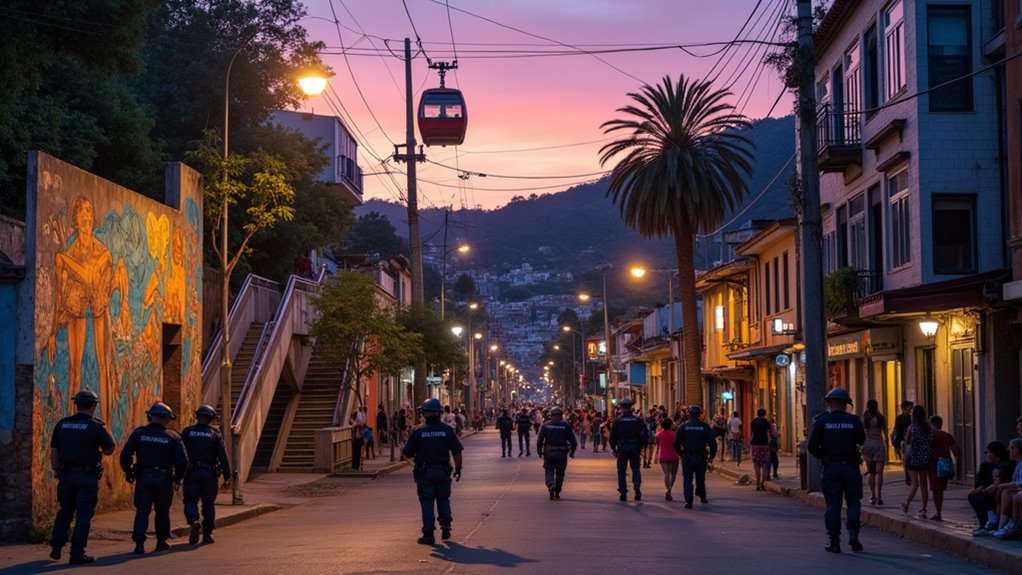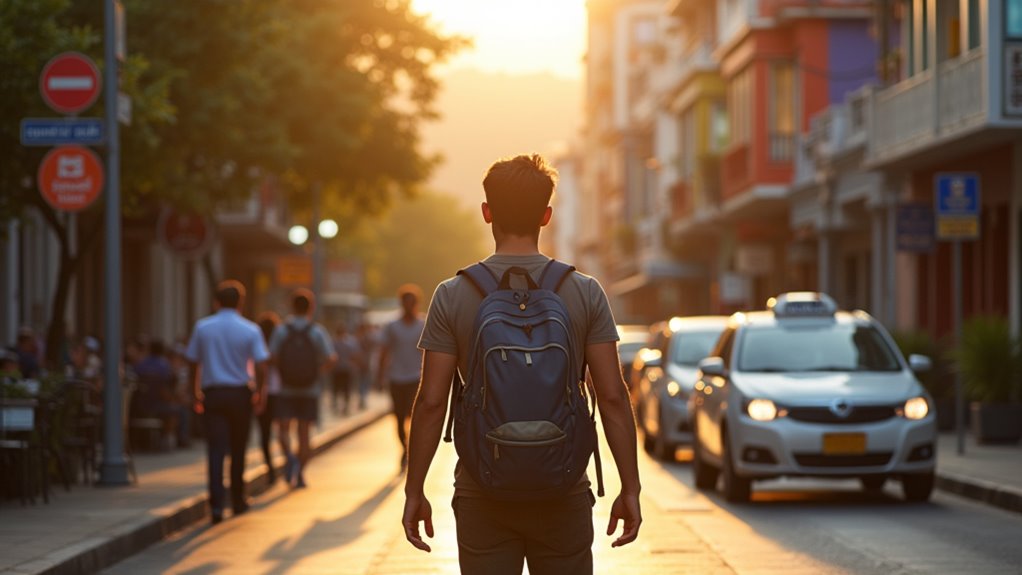Physical Address
304 North Cardinal St.
Dorchester Center, MA 02124
Physical Address
304 North Cardinal St.
Dorchester Center, MA 02124

Plagued by misconceptions, Medellín offers safe travel experiences when visitors understand which neighborhoods to embrace and which precautions to take.
Medellín has transformed dramatically from its violent past, but caution remains essential. You’ll find it reasonably safe if you stay in secure neighborhoods like El Poblado or Laureles, avoid flashing valuables, use official taxis or rideshares, and remain vigilant in tourist areas. Be particularly wary of scopolamine druggings, carry minimal cash, and don’t accept drinks from strangers. Smart precautions will help you enjoy the city’s vibrant culture and innovation safely.

While Medellín once held the infamous title of the world’s most dangerous city during Pablo Escobar’s reign, today’s reality couldn’t be more different. Following Escobar’s death in 1993, the city began a remarkable transformation that continues today.
Innovative urban planning has played a pivotal role in this evolution. You’ll notice the world’s first urban cable car system connecting previously isolated neighborhoods, dramatically reducing crime rates. The installation of electric escalators in neighborhoods like Comuna 13 has reduced a 25-minute climb to just 6 minutes, improving residents’ daily lives and generating tourism.
Social programs targeting poverty and community engagement have rebuilt trust among residents, while economic development has created opportunities where desperation once ruled.
The results are striking: murder rates have plummeted from their 1990s peak, middle-class families are returning, and Medellín has earned international recognition as a model for urban resilience and civic renewal.
Today’s Medellín presents a complex safety picture that reflects both the city’s transformation and ongoing challenges. While official homicide rates have decreased compared to historic highs, other crime categories show concerning trends you should be aware of.
Medellín showcases remarkable progress while still grappling with safety issues that demand visitor vigilance.
Property crimes and street robberies remain prevalent, with criminals increasingly using weapons to intimidate victims. The city sees about 56 criminal arrests daily, indicating active police response but persistent illegal activity. Colombia’s government has significantly increased public security spending by 220% from 2010 to 2023 to combat these crime issues.
Key crime concerns include:
As a visitor, you’ll face different risks than locals, primarily targeting your belongings rather than violent confrontation.

Despite Medellín’s remarkable transformation in recent years, travelers face several significant safety threats that require vigilance and preparation. Armed robberies remain common, with criminals sometimes using firearms and targeting visitors in broad daylight. Tourists should be aware that these incidents frequently occur in popular tourist areas, including near trendy hotels and other public spaces. Your belongings, especially phones and wallets, can be snatched in busy urban areas.
Drug-facilitated crimes pose a serious threat, particularly scopolamine (“burundanga”), which criminals use to incapacitate victims before robbing them. You’ll also need to watch for pickpockets and scammers who may pose as police officers or friendly locals.
Women and solo travelers should be especially cautious of sexual assault risks in nightlife districts and isolated areas. While less common, kidnappings still occur, typically targeting those perceived as wealthy.
Avoid demonstrations and civil unrest, which can escalate unpredictably.
Medellín’s troubled history with the drug trade continues to cast a shadow over the city, presenting specific risks you’ll need to navigate as a visitor. While the Medellín Cartel’s heyday under Pablo Escobar ended in 1993, Colombia remains a major cocaine producer with ongoing narco-trafficking activity. The country has been the world’s leading coca producer for many years, though production has decreased significantly since its peak in 2000.
Be especially vigilant about “scopolamine” (devil’s breath), a powerful drug criminals use to rob or kidnap victims. Protect yourself by:
Colombian authorities have strengthened policing efforts and international cooperation to combat trafficking, but your personal awareness remains your best defense against drug-related risks.

While exploring the vibrant streets of Medellín requires common sense precautions, you’ll find that following a few practical guidelines can considerably enhance your safety.
Always stay informed by monitoring local news and travel advisories. Use the metro during daylight hours but opt for door-to-door services like Uber at night. Stick to well-lit areas and tourist zones such as El Poblado, especially after dark. Avoid displaying valuables or carrying large amounts of cash—credit cards are safer alternatives.
Learn basic Spanish phrases to help in emergency situations, and memorize local emergency numbers. When possible, join guided tours or groups rather than venturing out alone. The city’s enhanced police presence in tourist areas significantly contributes to visitor safety.
Blend in by dressing modestly and staying aware of your surroundings. Remember, most travelers enjoy Medellín safely by following these simple practices.
Understanding where to stay and which areas to avoid can make or break your Medellín experience. El Poblado remains the safest option with upscale amenities, while Laureles offers a quieter atmosphere popular with expats. Envigado and Sabaneta provide authentic local experiences if you’re comfortable with basic Spanish. Downtown Centro is generally safe for daytime exploration but should be avoided after dark unless you’re with companions.
Choosing the right neighborhood in Medellín directly impacts your Colombian experience—from luxury to local authenticity.
For safety, avoid staying in:
Even in safer neighborhoods, stay on well-lit streets, avoid walking alone at night, and remain aware of your surroundings. Neighborhood safety can change quickly, so always check with local accommodation providers for current conditions.

Should an emergency arise during your Medellín visit, knowing how to access help quickly becomes essential. Dial 123 for any emergency—this is Colombia’s universal emergency number that connects you to police, medical services, and fire departments.
For medical emergencies, Medellín offers a responsive EMS system serving 2.4 million residents with well-coordinated prehospital care. The city’s hospitals provide quality emergency treatment for everything from trauma to cardiac events. Though Medellín has made progress in emergency care, the city still faces challenges due to limited specialists available outside major urban centers.
If you’re facing security concerns, use specialized numbers: 147 (National Police) or 165 (Armed Forces) for kidnapping or extortion threats, and #767 for other emergencies.
Local authorities encourage immediate reporting of any incidents, ensuring you’ll receive prompt assistance from trained professionals who maintain Medellín’s reputation for excellent emergency care in Latin America.
You’ll find today’s Medellín dramatically safer than its notorious past, with violent crime down 95% since the Pablo Escobar era. Stay vigilant in crowded areas, avoid flashing valuables, and stick to tourist-friendly zones like El Poblado and Laureles. Trust your instincts, use reputable transportation, and keep emergency contacts handy. With reasonable precautions, you’ll experience the warmth and beauty that’s made Medellín a rising star in South American travel.